Doberman pinschers are sleek yet muscular dogs that exude an aristocratic air. These dogs were first bred in Germany by a 19th-century tax collector named Louis Dobermann. Facing hostility for collecting taxes, he needed a loyal and imposing dog to protect him as he went around daily.
Today’s Doberman remains one of the best working dogs and guardian breeds. This article will closely examine Doberman Pinscher’s progression, growth chart, milestones, and some training tips.
Doberman Pinscher Breed Summary
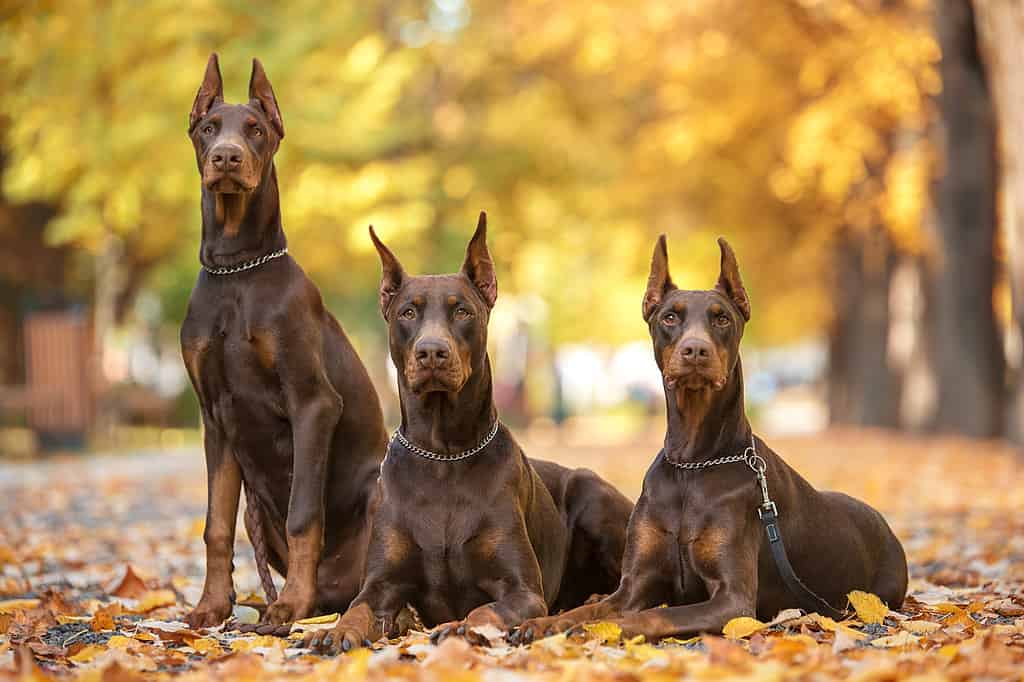
Doberman pinschers come in silky black, blue, red, or fawn coats.
©sssss1gmel/iStock via Getty Images
With their sleek and robust build, Dobermans are an intimidating dog breed. However, that appearance makes them great military, police, and guard dogs. These dogs are muscular and so fast that they can run 32 miles per hour.
Additionally, their hearing is naturally keen, and docking their ears is unnecessary for optimal hearing. Many places, such as Europe, have banned ear docking altogether because it’s unnecessary and cruel. Dobermans naturally have floppy ears like a hound’s and a longer tail if they’re not docked.
Although this breed may be known for being aggressive, they can also be gentle family dogs if trained and socialized correctly. Training these intelligent and often stubborn dogs takes a capable person. If they are raised in a loving home and trained with positive reinforcement, they make excellent pets.
Doberman Pinscher Growth and Weight Chart By Age
Dobermans grow rapidly during their first year of life. Sometimes, they reach their full height by 9 to 12 months. Their weight continues to increase until they’re three years old. Between 1 and 2 years, they typically gain muscle as they fill out.
| Age | Male Weight | Female Weight |
|---|---|---|
| Birth to 1 Week | 1 to 1.5 pounds | 0.9 to 1.3 pounds |
| 1 Month | 5 to 9 pounds | 4.5 to 8 pounds |
| 2 Months | 16 to 20 pounds | 15 to 18 pounds |
| 3 Months | 24 to 30 pounds | 22 to 27 pounds |
| 4 Months | 32 to 42 pounds | 29 to 38 pounds |
| 5 Months | 40 to 52 pounds | 35 to 47 pounds |
| 6 Months | 48 to 60 pounds | 42 to 53 pounds |
| 9 Months | 60 to 75 pounds | 50 to 63 pounds |
| 12 Months | 70 to 85 pounds | 55 to 70 pounds |
| 2 Years | 75 to 95 pounds | 60 to 77 pounds |
| 3 Years | 80 to 100 pounds | 62 to 80 pounds |
When Will My Doberman Pinscher Stop Growing?
Dobermans stop growing in height by about 12 months of age. After the first year, though, they will continue to put on some weight and muscle for the next year or longer. While they continue bulking up, they will also continue to mature.
Male Dobermans are not deemed in their prime until they’re about three years old. A female is considered in her prime when she’s about two years old. When these dogs reach seven years old, they’re considered seniors and begin to slow down.
When Should My Doberman Pinscher Be Spayed or Neutered?
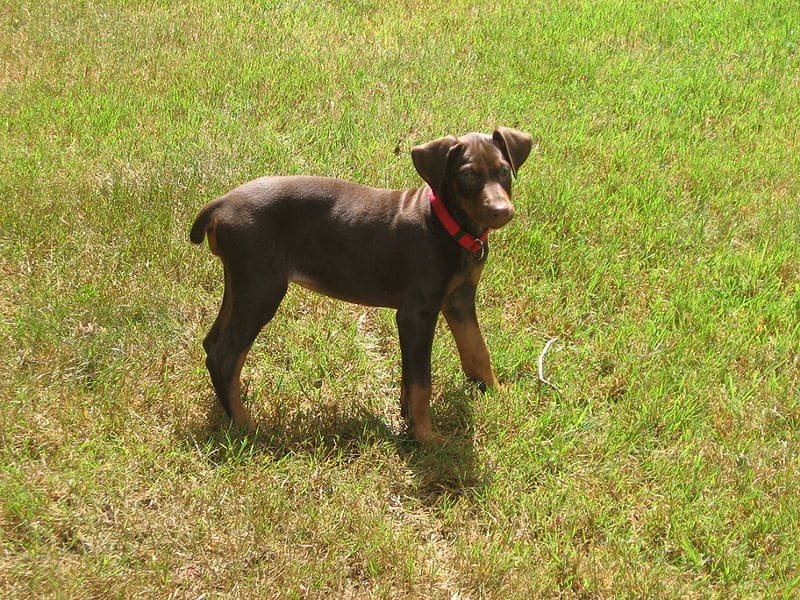
©M. Peterson / Creative Commons – Original
Most puppies reach sexual maturity around 6 to 9 months of age.
Most vets recommend having your pet spayed or neutered. Doberman pinscher puppies are no exception to this. In addition to preventing unwanted litters, this procedure may reduce the risk of some types of cancer.
Your dog’s vet will know the best time to have your Doberman spayed or neutered. The general rule of thumb is to wait until after they sexually mature. The AKC believes that the dog’s vet should decide when to spay or neuter any dog individually.
When Should My Doberman Pinscher Be House Trained?
You can start to housetrain your puppy at about eight weeks old. Remember, however, that Doberman puppies have long memories. One negative experience can override a hundred positive ones. Therefore, there are three critical things to remember when housetraining your puppy:
- Use positive reinforcement as with every other type of training you do.
- Stay committed to the training and keep it consistent.
- Crate Training is a substantial first step to successful housetraining.
One of the first things almost any reputable trainer will recommend is never punishing a dog for having an accident in the house. If you see your puppy starting to relieve themselves indoors, quickly get them outside to finish their business and then praise them. Commitment and consistency come into play when you keep your puppy on a schedule and remain vigilant about their potty needs.
When Should My Doberman Pinscher Stop Eating Puppy Food?
From the time your Doberman pup is six weeks to about 12 weeks of age, they need to eat food that has the specific nutritional content that a puppy needs. At this point, you should plan to feed them four times a day. At 12 weeks until about six months, you can decrease that to 3 times a day. After six months of age, you can start to feed your pup twice a day.
When your pup reaches between 12 and 14 months, you can switch from puppy food to adult food. However, Dobermans are large-breed dogs, so they aren’t physically mature until about 24 months. Therefore, you should consult your dog’s vet about the best time to switch from puppy food to adult food for your Doberman.
When Will My Doberman Pinscher Start Losing Teeth?
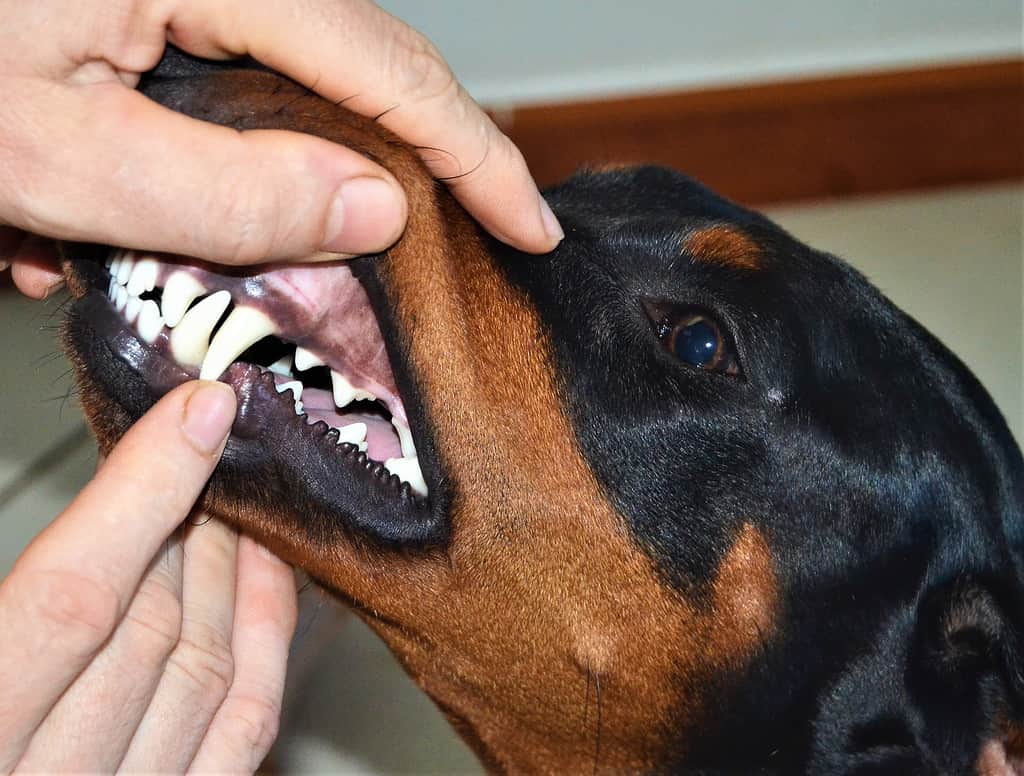
Puppies go through a teething phase, much like human infants.
©Markus Frenzel/iStock via Getty Images
When Doberman puppies reach about 12 weeks of age, they lose teeth. Contrary to how human babies teeth, though, these pups already have their teeth. Rather than feeling sore from teeth growing in, puppies get irritated and swollen gums from their baby teeth starting to fall out.
Starting at three months, you may notice baby teeth on the floor as your Doberman loses them. Most likely, however, your dog will swallow them as they loosen, which is natural and nothing to worry about. Most of their adult teeth — except their canines and carnassial teeth — will begin to grow by six months of age.
When Should I Start Training My Doberman Pinscher?
One of the truly unique characteristics of Dobermans is that they’re highly intelligent. Even the smallest puppies can be successfully trained. The Doberman Pinscher Club of America describes this breed as closer to acting human than any other dog breed. They have an innate intuition about what their owners want from them and what they’re thinking.
When you bring them home, puppies should be socialized with people and other animals. You can also start housetraining them right away. You can begin training your Doberman puppy between 8 and 16 weeks of age.
What Cues Should I Teach My Doberman Pinscher First?
Some basic commands are essential for helping your puppy become well-mannered and keep them safe. Let’s look at these essential cues to teach your Doberman.
- Teaching your dog the stay command will help to keep them from running into dangerous situations.
- It would be best if you taught your dog to come on command, which ensures their safety and the safety of others.
- By teaching the cue to sit, you’re getting your dog used to waiting for guidance when navigating the outside world.
- The heel command lets you walk your dog loosely on their leash without tugging or pulling.
- You’ll most likely want to teach your Doberman the down cue. Given the breed’s size and intimidating appearance, you probably won’t want them to jump up on people.
- Dogs put almost everything in their mouths — including potentially toxic and dangerous things. Teaching your dog to drop it will ensure you can avoid any illness or fatalities due to accidental poisoning.
When Will My Doberman Pinscher Calm Down?

Doberman pinschers are a highly energetic breed, so they need positive outlets to expend their energy.
©Marko Ignjatovic/iStock via Getty Images
Doberman pinschers are known for their many commendable attributes. Specifically, they’re steadfast, vigilant, strong-willed, observant, courageous, and spirited. The last attribute can be overwhelming if you don’t give your pup outlets to expend some of their energy. They need a lot of exercise because of this very high activity level.
It’s crucial to continuously keep an eye on your Doberman when they’re puppies. In addition to being constantly on the go, they’re also very curious. This means they like to get into everything. It’s important to have a fenced-in yard in which your Doberman can run with their inherent extreme bursts of speed. It’s also important to take them on long walks throughout the day.
Fortunately, with enough exercise and mental stimulation, your Doberman should begin to calm down noticeably when they turn 1 year old. By the time they reach full maturity at about 2 to 3 years old, they’ll become even more unexcitable.
Common Health Issues Your Doberman Pinscher Might Experience
Dobermans are amazing dogs that don’t require much grooming. Additionally, they can be relatively healthy, but it’s essential that you feed your dog high-quality food, give them proper exercise, and take them for regular veterinary checkups. Even with the best care, there are some health issues that Dobermans are prone to as a breed.
- Dilated Cardiomyopathy
- Hip Dysplasia
- Chronic Active Hepatitis
- Cervical Vertebral Instability
- Von Willebrand Disease
- Hypothyroidism
- Gastric Dilatation and Volvulus Syndrome (Bloat)
The average lifespan of the Doberman is 10 to 13 years. As with any dog, it’s important to monitor any changes to your Doberman’s health and habits and share that with your veterinarian. With proper health care, your Doberman could live a healthy and long life.
Pictures of Doberman Pinschers as Puppies
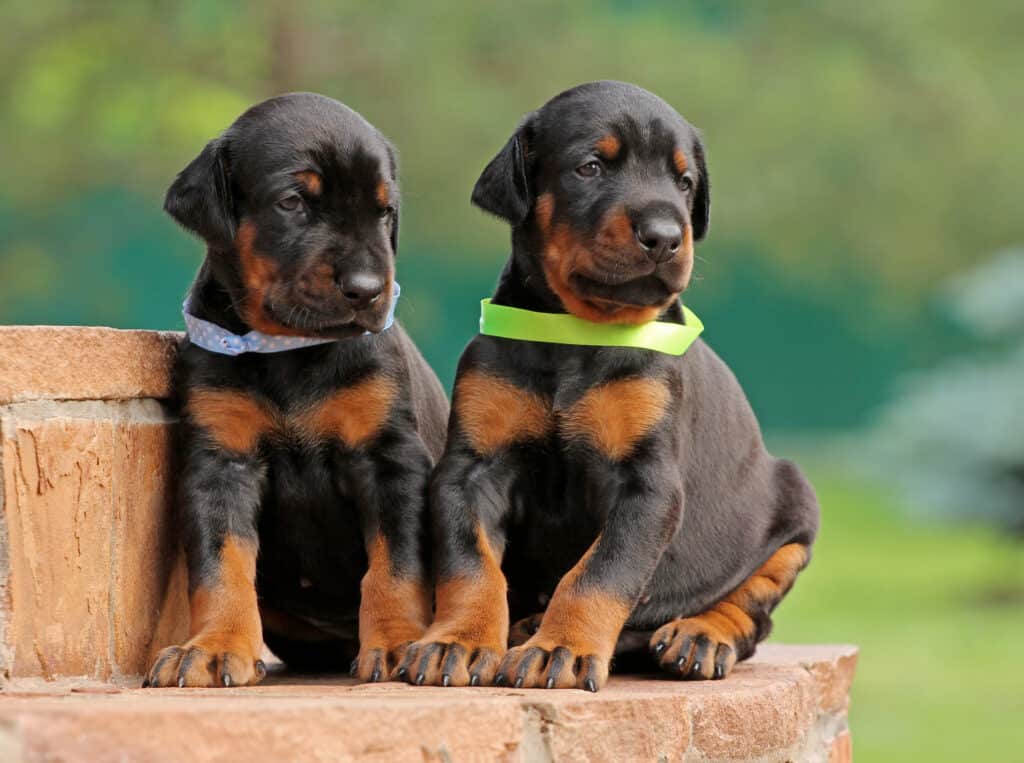
Dobermans need to be socialized with other dogs and people from when they’re puppies.
©Pavel Shlykov/Shutterstock.com
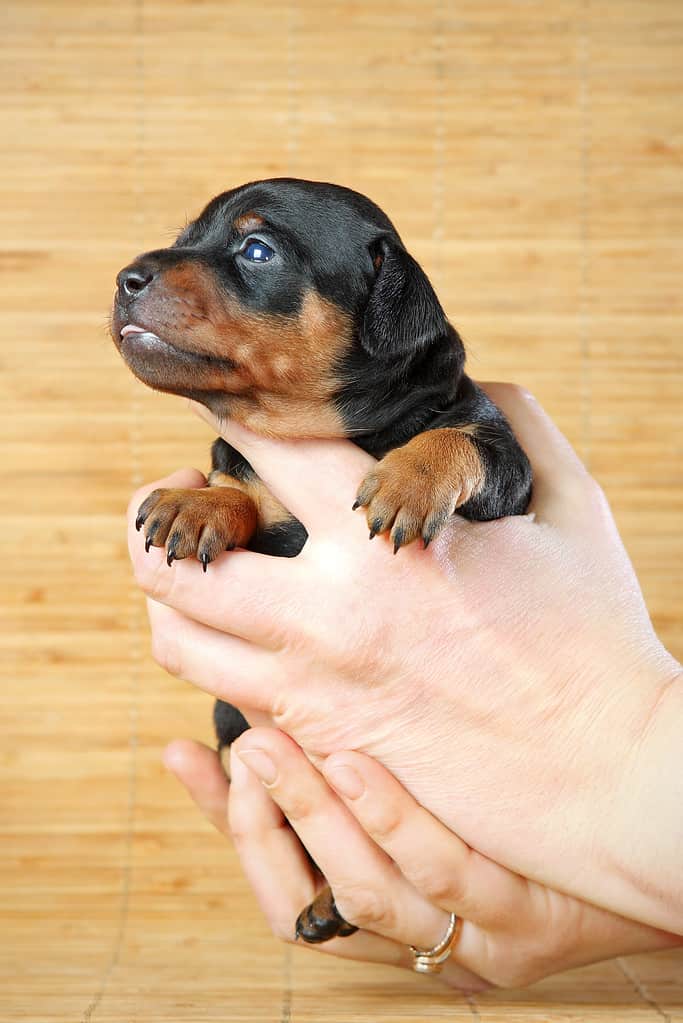
Doberman pinscher puppies weigh only a little more than a pound at birth.
©pozitivstudija/iStock via Getty Images

Doberman pups are born with floppy ears.
©Vukasin Ljustina/iStock via Getty Images
Pictures of Doberman Pinschers at 6 Months

By the time a Doberman puppy reaches the 6-month mark, they can weigh anywhere from 42 to 60 pounds.
©Fotoarta/iStock via Getty Images
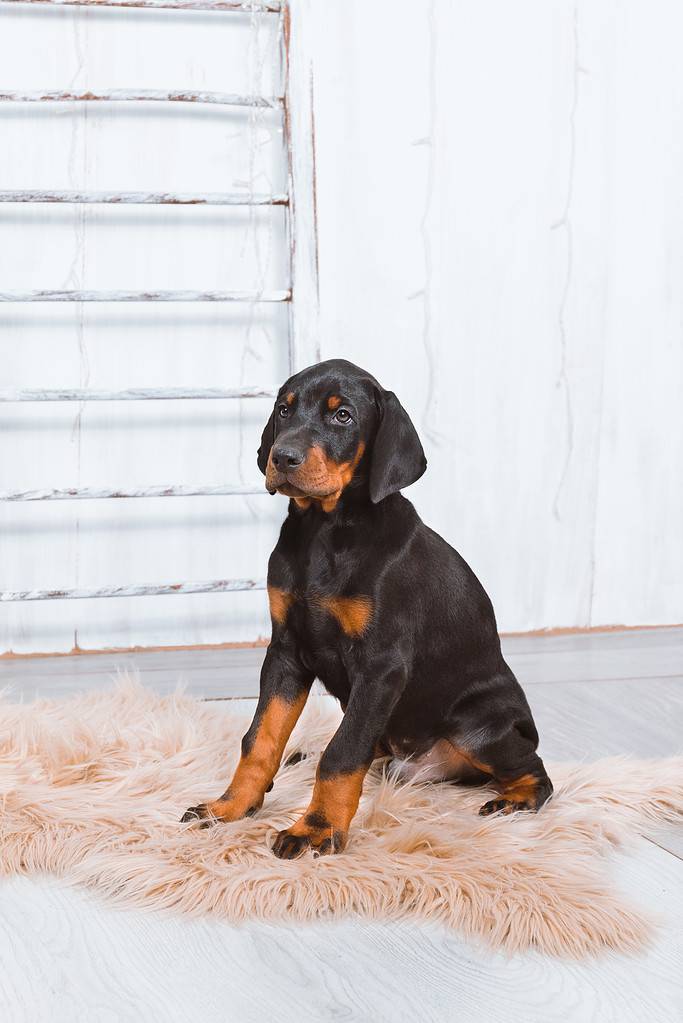
Doberman puppies should have been socialized, trained in the basic safety commands, and housetrained before they’re six months old.
©Elena Neveditsyna/iStock via Getty Images
Pictures of Fully Grown Doberman Pinschers
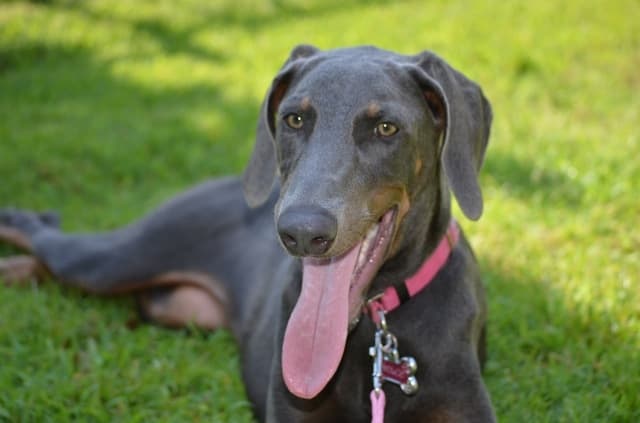
Doberman pinschers do not need their ears docked, and many places ban it.
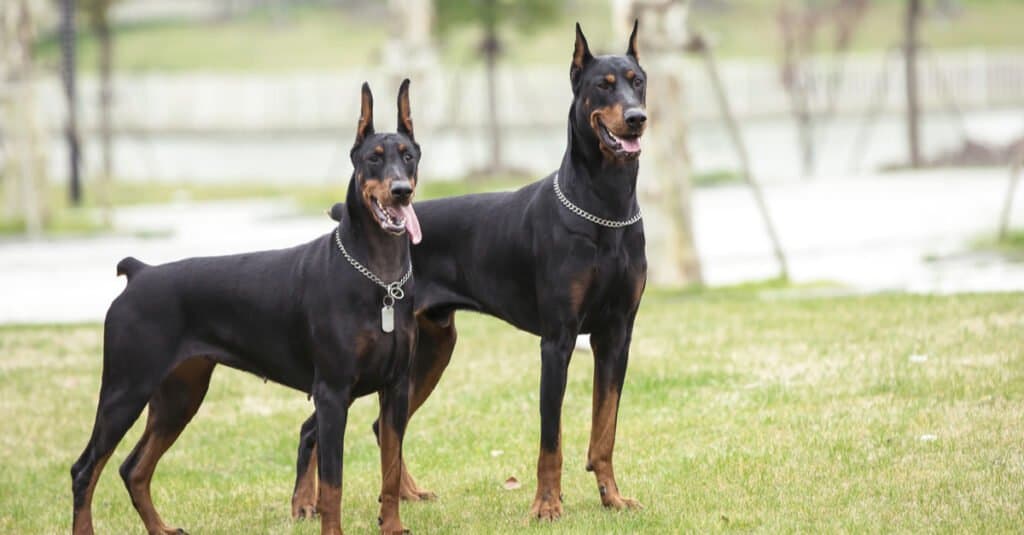
Doberman pinschers are sleek, muscular, and elegant-looking dogs.
©Jenson/Shutterstock.com
The photo featured at the top of this post is © DragoNika/Shutterstock.com
Ready to discover the top 10 cutest dog breeds in the entire world?
How about the fastest dogs, the largest dogs and those that are -- quite frankly -- just the kindest dogs on the planet? Each day, AZ Animals sends out lists just like this to our thousands of email subscribers. And the best part? It's FREE. Join today by entering your email below.
Thank you for reading! Have some feedback for us? Contact the AZ Animals editorial team.







